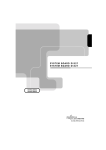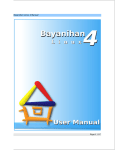Download Fujitsu D1544 Computer Hardware User Manual
Transcript
answers 2 Technisches Handbuch / Technical Manual Mainboard D1544 Deutsch / English Sie haben ... ... technische Fragen oder Probleme? Wenden Sie sich bitte an: • Ihren zuständigen Vertriebspartner • Ihre Verkaufsstelle Weitere Informationen finden Sie im Handbuch "Sicherheit" und "Ergonomie". Aktuelle Informationen und Updates zu unseren Mainboards finden Sie im Internet: http://www.fujitsu-siemens.com Are there ... ... any technical problems or other questions you need clarified? Please contact: • your sales partner • your sales outlet You will find further information in the manuals "Safety" and "Ergonomics". The latest information and updates on our mainboards can be found on the Internet under: http://www.fujitsu-siemens.com Dieses Handbuch wurde auf Recycling-Papier gedruckt. This manual has been printed on recycled paper. Ce manuel est imprimé sur du papier recyclé. Este manual ha sido impreso sobre papel reciclado. Questo manuale è stato stampato su carta da riciclaggio. Denna handbok är tryckt på recyclingpapper. Dit handboek werd op recycling-papier gedrukt. Herausgegeben von/Published by Fujitsu Siemens Computers GmbH Bestell-Nr./Order No.: A26361-D1544-Z120-1-7419 Printed in the Federal Republic of Germany AG 0403 04/03 A26361-D1544-Z120-1-7419 Mainboard D1544 TECHNISCHES HANDBUCH TECHNICAL MANUAL Deutsch English Mainboard D1544 Technisches Handbuch Technical Manual Ausgabe April 2003 April 2003 edition Intel, Pentium und Celeron sind eingetragene Warenzeichen der Intel Corporation, USA. Microsoft, MS, MS-DOS und Windows sind eingetragene Warenzeichen der Microsoft Corporation. PS/2 und OS/2 Warp sind eingetragene Warenzeichen von International Business Machines, Inc. Alle weiteren genannten Warenzeichen sind Warenzeichen oder eingetragene Warenzeichen der jeweiligen Inhaber und werden als geschützt anerkannt. Copyright Fujitsu Siemens Computers GmbH 2003 Alle Rechte vorbehalten, insbesondere (auch auszugsweise) die der Übersetzung, des Nachdrucks, der Wiedergabe durch Kopieren oder ähnliche Verfahren. Zuwiderhandlungen verpflichten zu Schadenersatz. Alle Rechte vorbehalten, insbesondere für den Fall der Patenterteilung oder GM-Eintragung. Liefermöglichkeiten und technische Änderungen vorbehalten. Dieses Handbuch wurde erstellt von cognitas. Gesellschaft für Technik-Dokumentation mbH www.cognitas.de Intel, Pentium and Celeron are registered trademarks of Intel Corporation, USA. Microsoft, MS, MS-DOS and Windows are registered trademarks of Microsoft Corporation. PS/2 and OS/2 Warp are registered trademarks of International Business Machines, Inc. All other trademarks referenced are trademarks or registered trademarks of their respective owners, whose protected rights are acknowledged. All rights, including rights of translation, reproduction by printing, copying or similar methods, even of parts are reserved. Offenders will be liable for damages. All rights, including rights created by patent grant or registration of a utility model or design, are reserved. Delivery subject to availability. Right of technical modification reserved. This manual was produced by cognitas. Gesellschaft für Technik-Dokumentation mbH www.cognitas.de Übersicht/Overview Mainboard D1544 Interne Anschlüsse und Steckplätze / Internal connectors and slots 1 2 3 DIMM 2 DIMM 1 CPU Pentium4 4 5 6 7 8 9 10 11 PCI 15 14 1= 2= 3= 4= 5= 6= 7= 8= 9= 13 12 Stromversorgung Prozessor / Power supply processor Lüfter Prozessor / Fan processor IDE-Laufwerke 3/4 / IDE drives 3/4 Bedienfeld / Front panel Gehäuseöffnung / Intrusion Diskettenlaufwerk / Floppy disk drive Stromversorgung / Power supply USB C/D (SmartCard) IDE-Laufwerke 1/2 / IDE drives 1/2 10 = 11 = 12 = 13 = 14 = 15 = USB E/F Batterie / Battery Steckbrücke J4 / Jumper J4 PCI-Steckplatz / PCI-Slot Lautsprecher-Anschluss / Speaker connector Steckbrücke 2 / Jumper 2 Optionale Komponenten / Optional components Externe Anschlüsse / External connectors LAN AUDIO A26361-D1544-Z120-1-7419 Umschlag/Cover Contents Übersicht/Overview Mainboard D1544 Mainboard D1544 .............................................................................................................................1 Notational conventions ..............................................................................................................1 Important notes..................................................................................................................................2 Information about boards ...........................................................................................................2 List of features...................................................................................................................................3 Special features.........................................................................................................................4 Interfaces and connectors ..............................................................................................................6 External ports ....................................................................................................................................6 LAN connector...........................................................................................................................6 Graphics port - Supported screen resolutions ............................................................................7 Internal ports and connectors ............................................................................................................7 Hard disk connection .................................................................................................................7 Add-on modules / Upgrading..........................................................................................................8 Replacing processor ..........................................................................................................................8 Removing and installing processors ..........................................................................................8 Mounting heat sink.............................................................................................................9 Upgrading main memory..................................................................................................................10 Adding PCI cards.............................................................................................................................11 PCI bus interrupts - Selecting correct PCI slot .........................................................................11 Replacing the lithium battery....................................................................................................13 Glossary ..........................................................................................................................................14 A26361-D1544-Z120-1-7419 Mainboard D1544 Your mainboard is available in different configuration levels. Depending on the configuration chosen, some of the hardware components described may not be available on your mainboard. Further information Additional descriptions (e. g. of the drivers) are contained: • • • in the readme files on your hard disk on the driver floppy disks included on the CD "Drivers & Utilities Collection" or "Drivers & Utilities" or "ServerStart". i The programme Acrobat Reader must be installed to be able to open the manuals. For more details please read the according readme.txt files. Notational conventions The meanings of the symbols and fonts used in this manual are as follows: ! indicates information which is important for your health or for preventing physical damage. i indicates additional information which is required to use the system properly. Ê Text which follows this symbol describes activities that must be performed in the order shown. Ë This symbol indicates that you must enter a blank space (press the Space Bar) at this point. Ú This symbol indicates that you must press the Enter key. Text in this typeface indicates screen outputs. Text in this bold typeface indicates the entries you make via the keyboard. Text in italics indicates commands or menu items. "Quotation marks" indicate names of chapters or terms. 1 - English A26361-D1544-Z120-1-74191 Important notes Important notes With the mainboard installed you must open the system to access the mainboard. How to dismantle and reassemble the system is described in the operating manual accompanying the system. Connecting cables for peripherals must be adequately shielded to avoid interference. ! Observe the safety notes in the operating manual of your system. Incorrect replacement of the lithium battery may lead to a risk of explosion. It is therefore essential to observe the instructions in the "Add-on modules / Upgrading" - "Replacing the lithium battery" section. Components can become very hot during operation. Ensure you do not touch components when making extensions to the mainboard. There is a danger of burns! The shipped version of this board complies with the requirements of the EEC directive 89/336/EEC "Electromagnetic compatibility". Compliance was tested in a typical PC configuration. When installing the board, refer to the specific installation information in the manual for the receiving device. i The warranty is invalidated if the system is damaged during the installation or replacement of expansions. Information on which expansions you can use is available from your sales outlet or the customer service centre. Information about boards To prevent damage to the mainboard, the components and conductors on it, please take great care when you insert or remove boards. Take great care to ensure that extension boards are slotted in straight, without damaging components or conductors on the mainboard, or any other components, for example EMI spring contacts. Remove the plug from the mains outlet so that system and mainboard are totally disconnected from the mains voltage. Be careful with the locking mechanisms (catches, centring pins etc.) when you replace the mainboard or components on it, for example memory modules or processors. Never use sharp objects (screwdrivers) for leverage. Boards with electrostatic sensitive devices (ESD) are identifiable by the label shown. When you handle boards fitted with ESDs, you must, under all circumstances, observe the following: • • • • • You must always discharge static build up (e.g. by touching a grounded object) before working. The equipment and tools you use must be free of static charges. Remove the power plug from the mains supply before inserting or removing boards containing ESDs. Always hold boards with ESDs by their edges. Never touch pins or conductors on boards fitted with ESDs. A26361-D1544-Z120-1-7419 English - 2 List of features List of features Onboard features D1544 Chipset i845G/GV Board size 218,6 mm x 230 mm VGA ! Audio Buzzer / int. Speaker Support -/! LAN / with Alert-on-LAN !/! IDE RAID TM FireWire / 1394 / i.LINK ® HI-SPEED USB 2.0 SmartCard Reader Support (USB / serial) ! /- Temperature monitoring ! System Monitoring ! Fujitsu Siemens Computers Keyboard Power Button Support ! Internal ports DIMM slots (DDR 266 SDRAM) 2 AGP Slot (4/8x, 32 bit, 66 MHz, 1.5 V) - PCI slot (32-bit, 33 MHz, 5 V and 3.3 V) 2 CNR Slot (Type A, AC‘97 only) - IDE Interface (Ultra DMA/100) 1 Floppy Interface (up to 1.44 Mbyte) 1 S/PDIF* (digital audio) - CD / AUX audio input 1/- Frontpanel Audio (headphone, microphone) - Wake On LAN IEEE 1394 connector* (FireWireTM / i.LINK®) - USB Ports* (2.0, ~480 MB/s) 2 Serial Ports* (FIFO, 16550 compatible) Fan Connectors PSU** / CPU / AUX1 / AUX2 -/1/-/- SMBus Connector* (Case Temperature) - Intrusion Connector* (Case Open) ! 3 - English A26361-D1544-Z120-1-7419 List of features External ports VGA D1544 1 Audio Mic. in / Line in / Line out / Speaker out 1/1/1/1 Game/MIDI - LAN (RJ-45) 1 PS/2 mouse/keyboard 1/1 USB Ports (2.0, ~480 MB/s) 4 Serial Ports (FIFO, 16550 compatible) 1 Parallel Port (EPP/ECP) 1 * for use with internal devices or optional Front or Rear panel ** not supported by standard power supplies Special features Your mainboard is available in different configuration levels. Depending on the configuration, your mainboards is equipped with or supports the features described in the following. Thermal Management and System Monitoring A microcontroller reliably protects your PC against damage caused by overheating. Overheating can lead to the data loss or processor damage. An ingenious fan control and monitoring system prevents unnecessary noise. Should the processor nevertheless become too hot at the maximum fan speed, then the processor clock rate will automatically be reduced so that the system continues to run stably. In addition, the microcontroller offers monitoring of, for example, system voltages (12 V, 5 V, CMOS), opening of the case and a watchdog function. The microcontroller operates independently of the operating system and the processor. All values are displayed with DeskView, DeskViewOEM or SystemGuard. Harddisk Password A password assignment for the hard disk is only possible with suitable, newer hard disks and prevents unauthorised access to the stored data. Harddisk Password is activated in the BIOS Setup. A26361-D1544-Z120-1-7419 English - 4 List of features DeskView / DeskViewOEM The network-capable manageability software DeskView/DeskViewOEM mainly consists of three modules: • • • DeskInfo shows the most important device data of the PCs in a network (local and/or on an administrator PC). DeskAlert monitors the operability of all major components and triggers alarms if necessary depending on the mainboard variant. DeskFlash carries out a BIOS update under Windows. IA-PC Instantly Available PC ensures fast availability of the PC from an energy-saving mode. Within just a few seconds the PC is in exactly the same state it was in when it was switched off without time-consuming booting. Depending on the operating system, the PC can be switched into an energy-saving mode with applications open by pressing the ON/OFF switch. 5 - English A26361-D1544-Z120-1-7419 External ports Interfaces and connectors The positions of the interfaces and connectors are shown on page "Cover". The components and connectors marked are not necessarily present on the mainboard. External ports The positions of the external ports are shown on page "Cover". LAN PS/2 keyboard port, purple PS/2 mouse port, green Serial interface, turquoise Parallel port/Printer, burgundy LAN connector USB - Universal Serial Bus, black Audio output (Line out), light green Microphone jack (mono), pink Audio input (Line in), light blue Speaker out, orange VGA connector, blue (monitor) LAN connector This mainboard has an Intel GD82562EX LAN controller (10Base-T/100Base-TX). The LAN controller is equipped with a 2 KB transmission and receiving buffer (FIFO) and supports WOL function through Magic Packet. The LAN RJ45 connector has two LEDs (light emitting diodes). 2 A26361-D1544-Z120-1-7419 1 1 = a connection exists (e.g. to a hub). 2 = Link Mode: the LAN connection is active. WOL mode: a Magic PacketTM is being received. English - 6 Internal ports and connectors Graphics port - Supported screen resolutions Depending on the operating system used, the screen resolutions in the following table refer to the mainboard screen controller. If you are using an external screen controller, you will find details of supported screen resolutions in the operating manual or technical manual supplied with the controller. Screen resolution 640 x 480 800 x 600 1024 x 768 1280 x 1024 Refresh rate (Hz) 120 120 100 100 bpp Colour 32 32 32 32 32 bit 32 bit 32 bit 32 bit Internal ports and connectors The positions of the internal ports and connectors are shown on the Cover. Additional information on some ports is also provided here. Hard disk connection An ultra ATA/66 or ultra ATA/100 hard disk must be connected with a cable especially designed for the ultra ATA/66 or ultra ATA/100 mode. Ê Connect the end of the cable marked with blue to the mainboard. 7 - English A26361-D1544-Z120-1-7419 Add-on modules / Upgrading ! Exit energy-saving mode, switch off the system and remove the power plug from the mains outlet, before carrying out any of the procedures described in this chapter! Even when you have switched off the device, parts (e.g. memory modules, AGP and PCI extension boards) are still supplied with power. Replacing processor Technical data • • Pentium 4 with 400/533 MHz Front Side Bus in the mPGA478 design up to 2.4 GHz Celeron with 400 MHz Front Side Bus in the mPGA478 design up to 2.0 GHz Removing and installing processors Ê Remove the fan that there may be and the heat sink. 3 2 4 5 1 A Ê Ê Ê Pull the lever in the direction of the arrow (1) and lift it as far as it will go (2). Remove the old processor from the socket (3). Insert the new processor in the socket so that the angled corner of the processor matches the coding on the socket (A) with regard to the position (4). i Ê The angled corner of the processor can also be at a different location than shown in the illustration. Push the lever back down until it clicks into place (5). 8 - English A26361-D1544-Z120-1-74198 Add-on modules / Upgrading Mounting heat sink Be sure to use heat conducting material between the processor and the heat sink. If a heat conducting pad (rubber-like foil) is already applied to the heat sink, then use it. Otherwise you must apply a very thin layer of heat conducting paste. Heat conducting pads can only be used once. If you remove the heat sink, you must clean it and apply new heat conducting paste before you remount it. Please note that, depending on the heat sink used, different heat sink mounts are required on the mainboard. i If a counter-plate is mounted on the underside of the mainboard for reinforcement, no heat sinks of the type "Intel Boxed" may be used. Otherwise the retaining clips of the heat sink will be damaged. When using an "Intel Boxed" heat sink, the mainboard must be converted. This conversion set is either included with the mainboard or is available separately. If no counter-plate is mounted, you can use both "Intel Boxed" heat sinks and standard heat sinks. If you use the "Intel Boxed" heat sink, the mainboard will bend due to the high pressure of the retaining clips. This behaviour is specified by Intel. 9 - English Ê Depending on the configuration variant, you must pull a protective foil off the heat sink or coat the heat sink with heat conducting paste before fitting it. Ê Depending on the processor variant, clips may also be supplied for mounting the heat sink that fix it in place. Ê When you have mounted the optional fan, connect the fan plug to the corresponding connection on the mainboard. A26361-D1544-Z120-1-7419 Add-on modules / Upgrading Upgrading main memory Technical data Technology: DDR 266 unbuffered DIMM modules 184-Pin; 2.5 V; 64 Bit, no ECC Size: 128 Mbytes to 1 Gbyte DDR 266 SDRAM Granularity: 128, 256 or 512 Mbyte for one socket At least one memory module must be installed. You may only use up to two double-sided or two single-sided memory modules for DDR 266. Memory modules with different memory capacities can be combined. ! You may only use unbuffered 2,5 V memory modules. Buffered memory modules are not supported. DDR-DIMM memory modules must meet the PC2100 specification. Installing a memory module 2 2 Ê Ê Ê Push the holders on each side of the memory compartment outwards. Insert the memory module into the location (1). At the same time flip the lateral holders upwards until the memory module snaps in place (2). A26361-D1544-Z120-1-7419 English - 10 Add-on modules / Upgrading Removing a memory module 1 1 Ê Ê Push the clips on the right and left of the compartment outward (1). Carefully remove the memory module from the compartment (2). Adding PCI cards Technical data: 32 bit / 33 MHz PCI slots 5 V and 3.3 V supply voltage 3.3 V auxiliary voltage PCI bus interrupts - Selecting correct PCI slot i To achieve optimum stability, performance and compatibility, avoid the multiple use of ISA IRQs or PCI IRQ Lines (IRQ sharing). Should IRQ sharing be unavoidable, then all involved devices and their drivers must support IRQ sharing. PCI IRQ Lines connect AGP slots, PCI slots and onboard components to the interrupt controller. PCI IRQ Lines are permanently wired on the mainboard. Which ISA IRQs are assigned to the PCI IRQ Lines is normally automatically specified by the BIOS. 11 - English A26361-D1544-Z120-1-7419 Add-on modules / Upgrading Monofunctional expansions cards: Standard AGP and PCI expansion cards require a maximum of one interrupt, which is called the PCI interrupt INT A. Expansion cards that do not require an interrupt can be installed in any desired slot. Multifunctional expansion cards or expansion cards with integrated PCI-PCI bridge: These expansion cards require up to four PCI interrupts: INT A, INT B, INT C, INT D. How many and which of these interrupts are used is specified in the documentation provided with the card. The assignment of the PCI interrupts to the PCI IRQ Lines is shown in the following table: Onboard Controller PCI slot USB 1,1 1st 2nd 3rd 1 (A) A - - - - - - - 2 (B) - - - - A A - 3 (C) - - A - - - - 4 (D) - A - - - - 5 (E) - - - - - 6 (F) - - - - 7 (G) - - - - 8 (H) - - - A - - - - - - - - - - - - - - C B - - A - - - - - - - - A D - - - - - B A - - - - - D C LAN Audio SMBus Modem 2 USB 2,0 1 AGP PCI Interrupt Line AC97 Use the first PCI slots that have a single PCI IRQ Line (no IRQ sharing). If you must use another PCI slot with IRQ sharing, check whether the expansion card properly supports IRQ sharing with the other devices on this PCI IRQ Line. The drivers of all cards and components on this PCI IRQ Line must also support IRQ sharing. A26361-D1544-Z120-1-7419 English - 12 Add-on modules / Upgrading Replacing the lithium battery In order to permanently save the system information, a lithium battery is installed to provide the CMOS-memory with a current. A corresponding error message notifies the user when the charge is too low or the battery is empty. The lithium battery must then be replaced. ! Incorrect replacement of the lithium battery may lead to a risk of explosion! The lithium battery may be replaced only with an identical battery or with a type recommended by the manufacturer. Do not throw lithium batteries into the household waste. They must be disposed of in accordance with local regulations concerning special waste. Make sure that you insert the battery the right way round. The plus pole must be on the top! The lithium battery holder exists in different designs that function in the same way. 3 2 4 2 1 3 Ê Press the locking lug in the direction of the arrow; the battery jumps somewhat out of the holder (1). Ê Ê Remove the battery (2). Push the new lithium battery of the identical type into the holder (3) and press it downward until it engages (4). 13 - English A26361-D1544-Z120-1-7419 Add-on modules / Upgrading Glossary The technical terms and abbreviations given below represent only a selection of the full list of common technical terms and abbreviations. Not all technical terms and abbreviations listed here are valid for the described mainboard. ACPI CAN Advanced Configuration and Power Management Interface Audio Codec '97 Accelerated Graphics Port Audio Modem Riser Alert On LAN Advanced Power Management Advanced Technology Attachment Basic Input Output System Baseboard management controller Controller Area Network CPU Central Processing Unit RDRAM CNR C-RIMM Communication Network Riser Continuity Rambus Inline Memory Module Dual Inline Memory Module Error Correcting Code RIMM RTC Electrical Erasable Programmable Read Only Memory Floppy disk controller SGRAM AC'97 AGP AMR AOL APM ATA BIOS BMC DIMM ECC EEPROM FDC FIFO FSB FWH GMCH GPA I2C IAPC ICH IDE IPSEC First-In First-Out Front Side Bus Firmware Hub Graphics and Memory Controller Hub Graphics Performance Accelerator Inter Integrated Circuit Instantly Available Power Managed Desktop PC Design I/O Controller Hub Intelligent Drive Electronics Internet Protocol Security A26361-D1544-Z120-1-7419 ISA Industrial Standard Architecture LAN LSA MCH MMX P64H PCI Local Area Network LAN Desk Service Agent Memory Controller Hub MultiMedia eXtension PCI64 Hub Peripheral Component Interconnect Preboot eXecution Environment Random Access Memory PXE RAM RAMDAC SB SDRAM SIMD Random Access Memory Digital Analogue Converter Rambus Dynamic Random Access Memory Rambus Inline Memory Module Real Time Clock Soundblaster Synchronous Dynamic Random Access Memory Synchronous Graphic Random Access Memory SMBus SVGA USB VGA Streaming Mode Instruction (Single Instruction Multiple Data) System Management Bus Super Video Graphic Adapter Universal Serial Bus Video Graphic Adapter WOL Wake On LAN English - 14


































